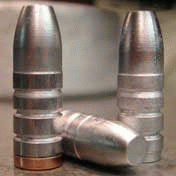

 The Accurate Reloading Forums
The Accurate Reloading Forums  THE ACCURATE RELOADING.COM FORUMS
THE ACCURATE RELOADING.COM FORUMS  Guns, Politics, Gunsmithing & Reloading
Guns, Politics, Gunsmithing & Reloading  Cast Bullets
Cast Bullets  weight varience in cast bullets.
weight varience in cast bullets.Go  | New  | Find  | Notify  | Tools  | Reply  |  |
| one of us |
I am seeing a difference in weight of my .44 315 grain bullets of 1-1 1/2 grains.Is this par for the course or will practice make perfect? By the way,these are a gas check bullet. Also is 1 or 2 grain a big deal anyway? | ||
|
| one of us |
Greg, This topic was recently discussed on graybeard's site. A variation of 1 to 1 1/2 grain in a bullet 300+ grains is only off by about .3% or maybe a little more. The difference is insignificant. I'd bet money some production bullets have more variation than yours. Don't sweat it. If the bullets look good after your molds get hot then shoot them. Don't spend all of your time weighing your bullets if they look good and have filled out bases. Spend more time putting them downrange. Beau | |||
|
| one of us |
Yep I'll second Beau, 1 and a half is insignificant on 315gr. I know I can't hold em close enough outa a handgun to see that small difference. | |||
|
one of us |
I shoot a Sharps 45/70 with lyman 530gn Postell projectile which weighs 525.0gn with my favourite mix. I weigh each and every one to 525+/- 0.1 I have sectioned a number of rejects to determine why a bullet that looks perfect can weigh up to 8-10gn less than my standard but found nothing. It can only be a bubble and unless it is on the center line of rotation the projectile will gyrate at a rate of approx 4000rpm. As a testiment to the weighing I have fired a 10 shotter at 100m with peep sights $ black powder where 8/10 grouped into just 22mm. | |||
|
| one of us |
gregp, I keep telling you that "if you keep your finger off the scale when weighing em' the suckers will weight the same!" Give em' books and send em' ta skule.... BTW, I sent you a PM. I'll talk to you in 2 weeks about blackie! best, bhtr | |||
|
| one of us |
Greg, G: I am seeing a difference in weight of my .44 315 grain bullets of 1-1 1/2 grains.. F: The practice of weighing bullets is one of those compulsive things folks do now and then. I do it myself now and then! Generally though, especially for bullets intended for shooting through a pistol or revolver this operation is unnecessary: If they pass a visual inspection, shoot them! In the production of Match grade bullets for various uses weighing is a useful thing to do because it is faster than measuring them with a micrometer. That is to say, weighing will show those bullets that got cast too hot, are undersize and will therefore act differently when fired for critical group shooting or at long range. Good morning, Forrest | |||
|
| one of us |
A 1 or 2 gr. difference in weight may or may not be significant, but that depends on what you're using the CB's for. For practice shooting, plinking, etc. it makes no difference. For a match, it may make all the difference in the world. In that case, I'd weigh and segregate them by perhaps .2gr. difference. Also, if your mould is a DC, the weight variation you're experiencing may be due to slight differences in the cavities themselves. Why not segregate the CB's by cavity as you cast, then load, say 50 rnds. from each cav. to see if there's any meaningful difference in accuracy? If there is, then consider weighing the CB's from each cavity too. ...Maven | |||
|
Moderator |
Don't worry about it, just shoot em! I'm glad my scale only goes to 110 gr, keeps me from being tempted to weigh my bullets. | |||
|
one of us |
Hello Greg- A comment to supplement those already posted by others... If the purpose of your weighing handgun bullets is to determine if they are OK to use - particularly for distances of 50yds and in - I wouldn't worry about the variation. However- If the purpose be to qualify your casting technique... This may be a worthwhile effort. That there is a 1-2 gr variation is an indication of one of two things I think. One - in a two or more cavity mould - it could indicate a difference in the cavities. If you are seeing this degree of variation from any one cavity - it is an indication of variation in casting technique. If you will shoot only short range in handguns or for plinking in general - it may be of no consequence. If you are nuts like some of us and are driven toward perfection, will use the bullets for longer range shooting, or want to see target accuracy - particularly from long guns; then spending some time refining your casting technique to minimize the variations will probably prove to be time well spent. Where can the variations come from... -variation in alloy as new material gets added to a pot when it runs low, if it was not from the same larger batch of alloy, it can be a source of changing the alloy density. -temp of alloy in the pot - colder alloy should be more dense -temp of the mould - affected by alloy temp variation and casting rythym -defects such as voids or inclusions -variation in casting technique that can affect degree of fill-out. Check bands and lube grooves for sharp fill out all the way around the bullet. If you cast with the nozzle in contact with the sprue plate, it will have a different "fill pressure" than if you cast from a distance away from the sprue plate. Similarly - variations in distance from Sprue plate, duration that the alloy is presented to fill, whether the pour is directly into the hole or deflecting from the side can all affect the degree of fill-out. Once you find what works - write it down to repeat again later on. This is especially helpful if you will use a variety of moulds since each one behaves differently. Best regards- Sky C. Longmont, CO | |||
|
| new member |
A lot of folk who weigh do so to find bubbles and other voids that make BIG weight differences. Having said that, you have to set them down again after you weigh them...so why not set them down in batches of like weight? You can do that in whatever strikes your fancy...all within the same 0.1 grain, all within half a grain, all within a grain, whatever rows your boat. Then shoot like with like. Consistency may not be absolutely necessary, but it can't hurt. | |||
|
| one of us |
I tried weighing my cast bullets when I first started casting some 18 years ago. I found with my LBT 300gr bullets, using WW metal they cast out at 315gr with the gas check. Upon weighing them, some were off as much as 5 grains. I kept these separate and loaded them to check and see the point of impact at 50 and 100yds. I load my 300gr bullets to a velocity of 1850+ in my 15" contender. At 50yds, the lighter/heavier bullets would still hit the same bored out hole that the bullets weighing 315gr. were hitting. At 100yds, I still did not see any deviation from the 315gr. bullets. My conclusion is that with this weight of bullet, 5 and maybe even 10 grains of variation in cast weight will not affect your shooting or the impact point to where you would not want to use them. | |||
|
| One of Us |
Of course, the necessity for weighing depends on the use to which you are putting the bullets. If acceptable groups are 3" at 100 yards, then large weight spans are likely O.K. On the other hand, if you want sub .4" groups at 100 yards, ca. 1.0" groups at 200 yards, and 12-15" groups at 1,000 yards, then weighing can be of measureable value. One may not tell the difference by shooting a few groups, but over several matches, against well-tuned competition, the differences will show. At least, that's my experience. | |||
|
| Powered by Social Strata |
| Please Wait. Your request is being processed... |
|
 The Accurate Reloading Forums
The Accurate Reloading Forums  THE ACCURATE RELOADING.COM FORUMS
THE ACCURATE RELOADING.COM FORUMS  Guns, Politics, Gunsmithing & Reloading
Guns, Politics, Gunsmithing & Reloading  Cast Bullets
Cast Bullets  weight varience in cast bullets.
weight varience in cast bullets.

Visit our on-line store for AR Memorabilia

